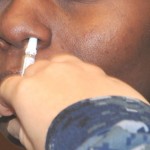 According to new research from NC State, vaccines may become more effective than ever before at preventing disease.
According to new research from NC State, vaccines may become more effective than ever before at preventing disease.
Since the summer of 2013, Cathy Fromen, a recent Ph.D. graduate from NC State, and her colleagues have explored how using nanoparticles not previously used in inhalable vaccines could improve the immune system’s response time to a vaccine in order to make it more effective at enabling the body to fight off diseases, such as tuberculosis and influenza.
A nanoparticle is a small object that behaves as a whole unit in terms of its transport and properties. For all intents and purposes, a nanoparticle can act as a deliveryman for the proteins of the vaccine, making it easier for the body to recognize the antigen protein.
“This creates a faster immune response time from the body,” Fromen said. “Using a nanoparticle also makes the immune response stronger and more effective. Overall, the immune system is much better prepared to fight a real virus.”
Because the inhalation method of receiving a vaccine is easier for the user, this research could possibly have an effect on the way vaccines are distributed to people living in third-world countries, according to Fromen.
“The inhalation method is painless and doesn’t create biohazard waste like a syringe would,” Fromen said.
The research team looked at the features of the nanoparticles, explicitly at their surface properties, in order to determine what types of properties give the strongest response from the immune system.
The research looked specifically at the inhalation method of receiving vaccinations. There is currently a nasal spray version of the influenza vaccine available for those who do not wish to have the shot, Fromen said.
“Receiving a vaccine to the lungs is better than the shot,” Fromen said. “It makes it easier for the body to process the vaccine.”
The form of vaccine using nanoparticles is still currently in development, as the team is still researching what happens to the nanoparticles once the body has absorbed the proteins and how to apply this approach to many different types of diseases.
The implications of this research could be enormous and there have already been clinical trials testing types of nanoparticle vaccines, according to Fromen.
Nicholas Martin, a junior studying biology, said he thinks this method of vaccination could become very popular.
“If the cost of the inhalation method is as much or only a little more than a standard syringe, then I see this as a beneficial progression,” Martin said.
Although the research is still being developed, Fromen said she and the rest of the team of scientists are excited and optimistic about the future possibilities for this form of vaccine to be used on a large scale.
Healthcare professionals currently administer vaccines for the flu or tuberculosis via shots that contain proteins called antigens. Antigens are molecules that come from a pathogen. A pathogen is a bacteria or virus which causes disease. The antigens look like the real virus but are harmless. The body is tricked into believing that it is under attack from the real pathogen. When the body detects the vaccine, it thinks it’s seeing a threat and begins to produce antibodies.
Following this experience, the body’s immune remembers how to respond to the antigen from the vaccine and can respond more effectively when it comes into contact with the real pathogen.
The team’s research was published in the “Proceedings of the National Academy of Sciences,” the official journal of the National Academy of Sciences.
Source: Technician online

















